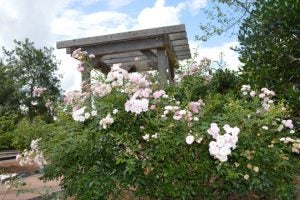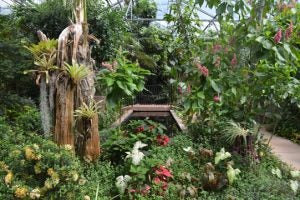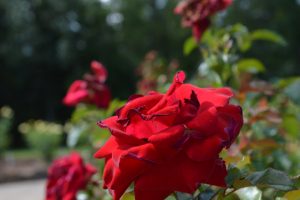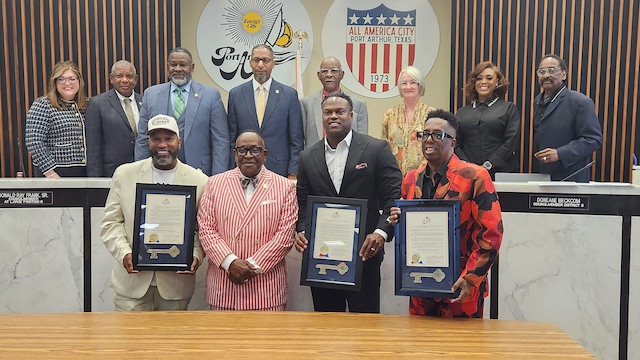Lush beauty, splendor: Beaumont Botanical Gardens
Published 12:47 pm Thursday, June 21, 2018

- Water lilies dot one of the small pools in the Warren Loose Conservatory. (Lorenzo Salinas/The News)
High gasoline prices and an economy still struggling to fully reboot means that Greater Port Arthur people may enjoy “staycations” this summer, reveling in the tourism sites within easy driving distance. The News will highlight 10 of these this summer, places we’d all do well to visit.
By Lorenzo Salinas
BEAUMONT — Beaumont has a natural splendor hidden in plain sight.
It’s filled with all kinds of flora, plants and flowers that one may not normally witness in Southeast Texas. Best of all, admission is free and it’s open to the public seven days a week.
The Beaumont Botanical Gardens are a public garden located near the entrance of Tyrrell Park on Babe Zaharias Drive. The Gardens are the oldest public gardens in Southeast Texas with several differently themed gardens comprising its 23.5-acre spread.
The Gardens are managed by the Beaumont Council of Garden Clubs, which consists of some 13 garden clubs, plant societies and nature-oriented organizations.
The Council develops and maintains the gardens with support from the city of Beaumont and various fundraisers and donations from individuals, organizations and businesses.

The Beaumont Botanical Gardens hold a wealth of plants, flowers and flora from far and wide within its many themed gardens and enclosures. (Lorenzo Salinas/The News)
A sprout of history
In 1968, the City of Beaumont set aside 10 acres of land in Tyrrell Park for the Beaumont Council of Garden Clubs to develop. This land would be the start of the Botanical Gardens.
The Gardens’ original Center Building was built using bricks from the Southern Pacific Railroad Passenger Station and was dedicated in 1971 when it was finished.
The Bert and Jack Binks Horticultural Center was dedicated in 2000 and serves as the information center for the Gardens and the entryway to the Warren Loose Conservatory.
In the same year, a fountain and Star Plaza was built to honor a 40-year Council member. The bowl of the fountain used to be the front of a railroad tank car. This is meant to remind folks of the significant petro-chemical industry in the area.
Despite two major hurricanes in 2005 and 2008 where damage was done to the various gardens and buildings, the Gardens weathered through the inclement weather with the help of nature, dedicated staff and the overwhelming support of Garden members.
Afterward, the Garden Center Building was remodeled, drainage throughout the Gardens was improved, its pond expanded and a rock waterfall was newly installed — just to name a few of the improvements that been enacted since Rita and Ike.
A bed of features
Visitors to the Gardens will be able to see numerous types of flowers and plants featured within its theme gardens.
In the Warren Loose Conservatory, an outstanding collection of lush tropical plants such as bromeliads, primitive ferns, cycads, agaves, aloes and cacti thrive within the 10,000-square-foot facility.
Within the paved Garden Plaza there sits a granite marker for Thyme for Herbs Society. The marker denotes the Herb Garden, which holds several herbal plants used for cooking, healing or emitting pleasant fragrances.
The Memorial Rose Arbor includes antique rose types from the 1800s such as climbing roses and fragrant roses, as well as a modern garden featuring hybrid varieties.
In Grandmother’s Garden, the Butterfly Garden serves as a home for monarch butterflies. It holds milkweed flora, the only food source for monarch larvae and other milkweed butterflies.
The 9/11 Memorial Garden is one of the first large, permanent memorials dedicated to first responders and those lost or injured during the September 11, 2001 terrorist attacks.
The Garden was dedicated on June 22, 2002 and holds soil from each of the three impacted sites. Red, white and blue flowers are cultivated in this area.
All the gardens are connected by the “Friendship Walk,” a concrete path that makes the gardens accessible to those in wheelchairs. The walk also has many benches situated alongside it to allow visitors to rest and appreciate the nature around them.
Adjacent to and accessible from Tyrrell Park sits Cattail Marsh, a 900-acre constructed wetland that is home to many species of waterfowl and shorebirds. Both the park and the marsh are featured on the Great Texas Coastal Birding Trail as renowned birding locations.

Imperial Japanese koi fish swim in a large pool in the Warren Loose Conservatory. (Lorenzo Salinas/The News)
A growth of interest
So far this year, from January to mid-June, the gardens have had approximately 3,500 visitors.
“It’s a great place to escape. There are lots of people who come after hours just to sit in the shade and read,” Botanical Gardner Doug Oldbury said.
Oldbury mentioned the calming effect that the gardens’ nature has on folks, from those that relax near the water to those who choose to stroll through the winding garden paths.
According to data collected by staff, Oldbury said the Botanical Gardens usually draw around 10,000 visitors each year from around the world.
Oldbury checked a visitor’s log and recounted garden guests from such varied places like El Salvador, Mexico, England, Colorado Springs, Houston, Lake Charles and Ohio — and that was only from half a month’s catalogue.
“Some years ago, ecotourism entered people’s vocabulary and it’s been building,” Oldbury said. “It’s not only the park, but places like national forests and lakes.”
Oldbury highlighted the importance of a place like the Botanical Gardens, where people could get away from the hustle and bustle of urban life and chill out amid Mother Nature.
“People with children sometimes have a hard time finding a place where they don’t have to spend $10 or $12 to enter,” he said. “Here, admittance is completely free. You can relax and enjoy the scenery.”

The Warren Loose Conservatory houses a variety of tropical plants from around the world. (Lorenzo Salinas/The News)
Hours and seasons
The Outside Gardens are open from daylight to dark every day.
The Binks Horticultural Center and Warren Loose Conservatory are open from 9 a.m. to 4 p.m. Monday, Tuesday, Thursday and Friday.
The buildings are open from 1 p.m. to 5 p.m. Saturday and Sunday from April through October and from noon to 4 p.m. from November through March.
They are closed on Wednesdays and major holidays.
Admission is free. To arrange group and school tours, call 409-842-3135.






